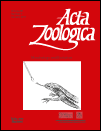View Item
- xmlui.general.dspace_homeCentros e Institutos de InvestigaciónCICVyA. Centro de Investigación en Ciencias Veterinarias y AgronómicasInstituto de GenéticaArtículos científicosxmlui.ArtifactBrowser.ItemViewer.trail
- DSpace Home
- Centros e Institutos de Investigación
- CICVyA. Centro de Investigación en Ciencias Veterinarias y Agronómicas
- Instituto de Genética
- Artículos científicos
- View Item
Spermatogenesis in the parasitoid Diachasmimorpha longicaudata (Hymenoptera: Braconidae)
Abstract
The study of spermatogenesis in Hymenoptera is limited to few taxa due to limitations to access the material in the right stage for analysis. The information available up to now states that the gametogenesis in males involves a modified meiosis, similar to mitosis. This is due to the haplodiploid sex determination system present in the order, where females are diploid and males are haploid. In the present work, we examined the spermatogenesis process in
[ver mas...]
The study of spermatogenesis in Hymenoptera is limited to few taxa due to limitations to access the material in the right stage for analysis. The information available up to now states that the gametogenesis in males involves a modified meiosis, similar to mitosis. This is due to the haplodiploid sex determination system present in the order, where females are diploid and males are haploid. In the present work, we examined the spermatogenesis process in the parasitoid Diachasmimorpha longicaudata (Ashmead) (Hymenoptera: Braconidae). We
performed squash preparations from testes of individuals from the third larval instar until the adult stage. Some cytological traits, such as the presence of a monopolar spindle, were analysed in detail by means of histological semi-thin sections. The spermatogenesis in this species comprises an abortive first division
with the formation of an anucleated cytoplasmic bud and a nucleated cell, and an equal second division of the nucleated cell, leading to the generation of two mature spermatozoa. The results presented herein provide more information
about the process of spermatogenesis in Hymenoptera, which has not been studied in depth in parasitic species.
[Cerrar]

Author
Carabajal Paladino, Leonale Suzel;
Lo Nostro, Fabiana Laura;
Papeschi, Alba Graciela;
Cladera, Jorge Luis;
Bressa, María José;
Fuente
Acta Zoologica 98 (1) : 38-43
Date
2017
ISSN
1463-6395
Formato
pdf
Tipo de documento
article
Palabras Claves
Derechos de acceso
Restringido
 Excepto donde se diga explicitamente, este item se publica bajo la siguiente descripción: Creative Commons Attribution-NonCommercial-ShareAlike 2.5 Unported (CC BY-NC-SA 2.5)
Excepto donde se diga explicitamente, este item se publica bajo la siguiente descripción: Creative Commons Attribution-NonCommercial-ShareAlike 2.5 Unported (CC BY-NC-SA 2.5)

